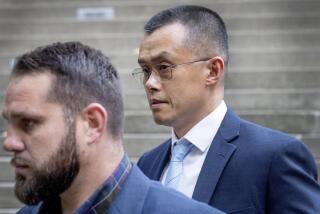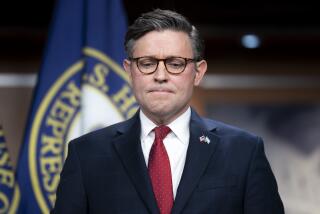One Issue That Bush and Clinton Won’t Touch : Bailout: Experts say another wave of bank and thrift failures looms after Election Day. For different reasons, neither candidate wants to talk about it.
- Share via
WASHINGTON — Neither George Bush nor Bill Clinton is talking about it, but a nasty surprise will confront the nation almost as soon as next month’s presidential election is over.
Experts say the savings and loan crisis, the bete-noire of national politics, could rear its head again with a vengeance in December, before the next President even has a chance to take the oath of office. And its evil twin, the banking crisis, will be right beside it.
More than 100 banks and thrifts could fail within months of the election because of tough new regulatory standards imposed last year, but purposefully delayed until after November.
The new rules, which take effect Dec. 19, make it more likely that regulators will seize troubled thrifts and banks once their capital falls to 2% or less of their core assets. Federal regulators say about 50 banks and 30 to 40 thrifts could be seized almost immediately.
And that is just the leading edge of what could be a new wave of failures as the biggest financial scandal in American history continues to sweep across the nation’s economic and political landscape.
Some analysts believe that as many as 700 more thrifts and 1,000 additional banks could go belly up in the coming years, especially if rising interest rates cause further losses at problem institutions.
Senior federal officials caution that at least half a dozen of the nation’s largest commercial banks are among those teetering on the edge of failure, although they decline to identify them publicly.
“We can run from this, but we can’t hide,” cautioned Robert Reischauer, director of the Congressional Budget Office.
Yet the federal agency created to deal with the thrift crisis is scheduled to go out of existence next fall, and Congress and the White House have not figured out what to do if the crisis has not abated by then.
Last week, Congress fled Washington for the year without approving $43 billion in funds needed to keep the government’s thrift cleanup agency running until next spring. Meanwhile, the Bush Administration has not yet asked Congress for any money to finance a new deposit insurance fund that is supposed to cover thrifts starting next fall.
The looming failures are likely to increase the cost of a bailout that has ballooned far beyond the initial estimates of even the Administration’s harshest critics. So far, the S&L; cleanup alone has cost taxpayers $84 billion; officials expect the figure to rise to at least $130 billion and with interest to more than $300 billion. In addition, new federal standards make it more likely that regulators will seize uninsured deposits--those above the $100,000 limit on federal insurance--to help pay the government’s costs of closing banks and thrifts. Before the new regulations went into effect, the federal government routinely covered uninsured deposits to avoid the possibility of runs on weak institutions.
Despite the continuing troubles, many observers contend that Washington has been playing politics with the issue all year, delaying any real action on S&Ls; and banks until after the election. Democrats accuse the Republican White House of deliberately delaying the closures of sick thrifts and banks in California and elsewhere in an effort to reduce the political fallout on President Bush. And Republicans say the Democratic Congress has purposefully deferred approving funds to finance the remainder of the S&L; cleanup.
“Bush claims that this problem is over, and that is dishonest,” charged Rep. Bruce Vento (D-Minn.), a key Democrat on S&L; and banking issues. “There is no question they have held off closing institutions this year. There is no question that there will be a December surprise.”
Countered Tim Ryan, director of the Office of Thrift Supervision: “It is an incredible situation, a ludicrous delay that is costing us $6 million a day, because Congress has refused all year to provide the money needed to finish the thrift cleanup.”
No matter who is to blame, the federal effort to clean up the S&L; and banking debacles has come to a virtual standstill since last spring. Bush’s desire to downplay the S&L; and banking crises during his reelection campaign is an understandable strategy, given his role in the deregulation drive of the Ronald Reagan Administration and his involvement in the cleanup that began under his Administration.
But Democrat Clinton has been strangely silent as well; in fact, the Democratic Party as a whole has seemed inclined to help Bush try to bury the mess.
Clearly, the issue makes the Washington establishment uneasy. The Democratic Congress, which has drawn fire for passing the legislation that helped foster the S&L; crisis in the early 1980s, seems to have swung to the other extreme. Increasingly fearful of the political impact of the financial crisis, Congress has, ironically, set the stage for the December surprise. Late last year, it approved the new regulations authorizing regulators to seize commercial banks whose capital falls to 2% or less of its assets. Previously, the government seized banks only after they had become insolvent.
Congressional leaders have said privately they believe the S&L; issue is double-edged: Both parties can be blamed for the debacle, and Democrats tend to get dragged down with Republicans any time the issue is raised.
But Clinton has never served in Congress and had nothing to do with the legislation that contributed to it. But, like Michael Dukakis, another Washington outsider who ran against Bush in 1988, Clinton has declined to make the thrift crisis a major issue.
“The campaign thinks it’s too complex,” observed Clinton economic adviser Rob Shapiro. Some outside analysts believe that questions about the involvement of Clinton and his wife with a failed Arkansas thrift, an issue that surfaced early in the presidential campaign, may have stifled his criticism of Bush on the issue.
Only independent presidential contender Ross Perot has sought to turn the crisis into a campaign issue, assailing Bush personally for the soaring costs of the S&L; and banking bailouts. In speeches, and in his new book, “United We Stand,” Perot has charged that Washington’s failure to deal with the financial disasters of the 1980s underscores the need for leaders who are willing to take personal responsibility for their actions.
Yet for the major party candidates, 1992 almost seems to be a replay of 1988, when the S&L; crisis was clearly ignored only to become a hot political issue the moment George Bush took office. Just 18 days after his inauguration, Bush introduced S&L; bailout legislation that his staff had worked on for months, but had gone unmentioned during the 1988 campaign.
“Nothing could be more ironic than the fact that one of the biggest public policy failures of the century was a non-issue in the last election, and is a non-issue again in this election,” noted Rep. Jim Leach (R-Iowa), a leading Republican on the House Banking Committee.
In 1989, George Bush designated L. William Seidman, chairman of the Federal Deposit Insurance Corp., as his point man on the S&L; crisis and the looming troubles in the banking industry. Seidman took on the added role of chairman of the Resolution Trust Corp., the agency created in 1989 to clean up the S&L; mess.
But three years later, Seidman left his twin posts without ever having met personally with the President to discuss the debacle.
For Seidman, the President’s chair was always empty during policy deliberations on the thrift bailout. Seidman said he believes that Bush deliberately kept his distance from the biggest financial disaster since the Depression.
“I met with (Treasury Secretary Nicholas F.) Brady, I met with (former White House Chief of Staff) John Sununu, but I never once saw the President,” Seidman said.
OTS chief Ryan, whom Bush appointed as chief S&L; regulator in early 1990, said in an interview that he has met with Bush only once. “It was either late last year or early this year, I can’t recall,” he said.
Even so, it has been difficult for Bush to distance himself entirely from the issue. As vice president, Bush chaired a Reagan Administration task force on financial deregulation that dealt with S&L; regulatory issues. In addition, almost all of the taxpayer bills have come due during his presidency, and the scandal has even touched his family: One of his sons, Neil Bush, has been censured by government regulators for his role in the failure of a Denver thrift where he served on the board of directors.
While Bush tries to keep the S&L; crisis at arm’s length, his aides have sought to make the case that the crisis is all but over, and that its resolution is only being delayed by an irresponsible Democratic Congress that refuses to provide the funds to close down a few remaining institutions.
Since assuming control of the RTC in February, RTC Chairman Albert Casey has tried to demonstrate that the Administration is on top of the crisis. He set a goal to sell $100 billion worth of real estate and other assets seized from insolvent S&Ls; by Oct. 1. He insists that all S&L; assets, even “the absolute dregs,” will be sold off by the end of 1996.
RTC spokesman Stephen Katsanos said preliminary figures indicate that the agency has met its goal. But he acknowledged that the RTC will have to count deals still in escrow, meaning the sales have not been finalized, to reach the objective.
Administration critics, as well as sources within the RTC, say the election-year push to rapidly dispose of assets has forced the agency to sell properties in huge blocks to rich investors at bargain-basement prices.
Times staff writer Robert A. Rosenblatt contributed to this report.
More to Read
Sign up for Essential California
The most important California stories and recommendations in your inbox every morning.
You may occasionally receive promotional content from the Los Angeles Times.













